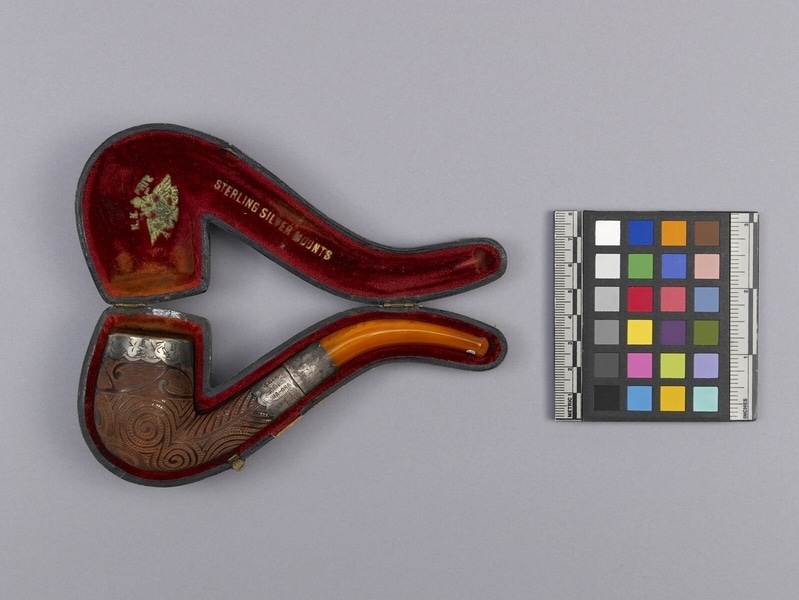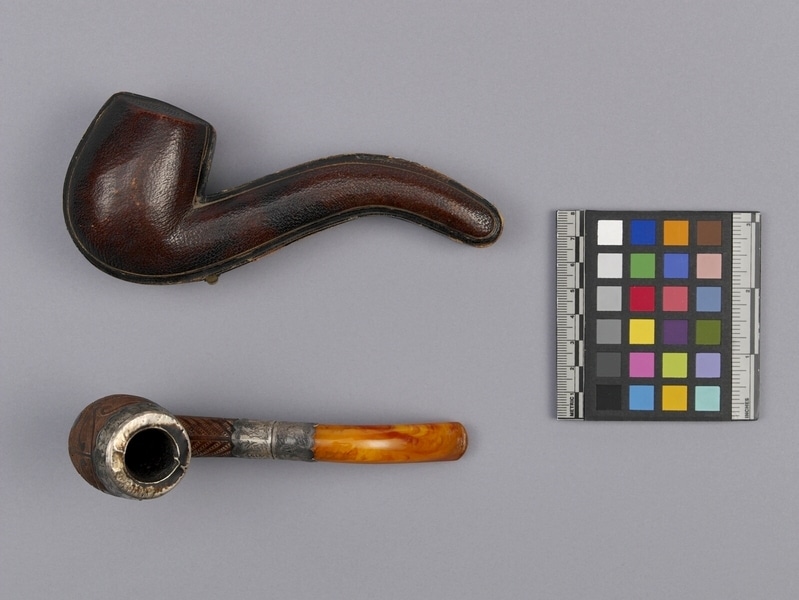Pipe Item Number: Ij10 a-b from the MOA: University of British Columbia



Description
A pipe with a case (part b). The pipe is wooden with a bird motif (tiki), spirals, and double spirals around plain eyes, corners of the mouth, abd along the sides, and the bottom with a plain tongue protruding. A chevron pattern is along the stem up to the silver bands. The silver is engraved with flowers along the rim, and the centre of the stem. The stem is loose with the rest of the stem being of orange (resin?). The bands on the stem have the letters "ller" and three symbols: an anchor, an "s", and a lion. Underneath the symbols, there is the word "kia-ora". The end of the stem has teeth marks, mostly on the underside. The case is brown leather, made in Vienna. It has a brass frame with hinges. The inside is red valour, and has the words, 'Sterling silver mounts', and a red bird emblem with the letters 'KK' on one side.
History Of Use
Traditionally carving was a sacred art with prescriptive taboos and an exclusive code of conduct. Some of these taboos included avoidance of food, women and tobacco. This pipe is an example of change in the post contact period. Elaborately carved pipes were non-traditional and new techniques and motifs were used to carve them. The wood for this pipe was bought from a wood merchant and European tools were used to carve it.
Iconographic Meaning
The motif is symbolic of birds. The protruding tongue is a symbol of defiance and magical protection from evil forces. The head is the most significant feature with spirals signifying points of movement.
Cultural Context
smoking
Narrative
This pipe was made for Edward James Legg (grandfather of donor Mrs. A. Gerow). Legg is said to have sailed to New Zealand, from England, c. 1888 at age 21. It was said to have been made for him by a Maori friend as a gift exchange. The silver band at centre was apparently added later in England.
Item History
- Made in New Zealand during 1890
- Collected between 1890 and 1950
- Owned by Edward James Legg
- Owned by A. Gerow and Mrs. A. Gerow before June 26, 1978
- Received from A. Gerow (Donor) and Mrs. A. Gerow (Donor) on June 26, 1978
What
- Name
- Pipe
- Identification Number
- Ij10 a-b
- Type of Item
- pipe
- Material
- fibre, resin ?, brass metal, leather skin, silver metal and wood
- Manufacturing Technique
- carved, moulded, nailed and engraved
- Overall
- height 10.0 cm, width 4.8 cm, depth 15.5 cm
- Part A
- height 5.5 cm, width 3.8 cm, depth 14.8 cm
- Part B
- height 10.0 cm, width 4.8 cm, depth 15.5 cm
Who
- Culture
- Maori
- Previous Owner
- Edward James Legg, A. Gerow and Mrs. A. Gerow
- Received from
- A. Gerow (Donor) and Mrs. A. Gerow (Donor)
Where
- Holding Institution
- MOA: University of British Columbia
- Made in
- New Zealand
When
- Creation Date
- during 1890
- Collection Date
- between 1890 and 1950
- Ownership Date
- before June 26, 1978
- Acquisition Date
- on June 26, 1978
Other
- Item Classes
- metalwork
- Condition
- good
- Current Location
- Case 55
- Accession Number
- 0466/0001 a-b